Abstract
Regulatory mechanisms of betacyanin biosynthesis in suspension cultures of Phytolacca americana and anthocyanin in Vitis sp. were investigated in relation to cell division activity.
Betacyanin biosynthesis in Phytolacca cells clearly shows a positive correlation with cell division, as the peak of betacyanin accumulation was observed at the log phase of batch cultures. Incorporation of radioactivity from labelled tyrosine into betacyanin also showed a peak at early log phase. Aphidicolin, an inhibitor of DNA synthesis, and propyzamide, an antimicrotubule drug, reduced betacyanin accumulation and inhibited the incorporation of radioactivity from labelled tyrosine into betacyanin at concentrations which were inhibitory to cell division. Both inhibitors reduced the incorporation of radioactivity from labelled tyrosine to 3,4-dihydroxyphenylalanine (DOPA), but the incorporation of labelled DOPA into betacyanin was not affected. These results suggest that the conversion of tyrosine to DOPA is coupled with cell division activity.
In contrast, the anthocyanin accumulation in Vitis cells showed a negative correlation with cell division. Accumulation occurred at the stationary phase in batch cultures when cell division ceased. Aphidicolin or reduced phosphate concentration induced a substantial increase in anthocyanin accumulation as well as the inhibition of cell division. Chalcone synthase (CHS) activity increased at the time of anthocyanin accumulation. Northern blotting analysis indicated that changes in CHS mRNA levels corresponded to similar changes in enzymatic activity. The pool size of endogenous phenylalanine was low during active cell division, but increased before anthocyanin began to accumulate and concomitantly with increasing levels of CHS mRNA. Exogenous supply of phenylalanine at the time of low endogenous levels induced the elevation of CHS mRNA and anthocyanin accumulation. These results indicate that the elevation of endogenous phenylalanine levels, when cell division ceases, may cause the increase in CHS mRNA levels, resulting in increased CHS activity and subsequently in anthocyanin accumulation in Vitis suspension cultures.
Similar content being viewed by others
Abbreviations
- CHS:
-
chalcone synthase
- CHFI:
-
chalcone flavanone isomerase
- DOPA:
-
3,4-dihydroxyphenylalanine
- PAL:
-
phenylalanine ammonia lyase
References
Hirose M, Yamakawa T, Kodama T & Komamine A (1990) Accumulation of betacyanin in Phytolacca americana cells and of anthocyanin in Vitis sp. cells in relation to cell division in suspension cultures. Plant Cell Physiol. 31: 267–271
Noé W, Langevartels C & Seitz V (1980) Anthocyanin accumulation and PAL activity in a suspension culture of Daucus carota L. Planta 149: 283–287
Sakuta M, Takagi T & Komamine A (1986) Growth related accumulation of betacyanin in suspension cultures of Phytolacca americana. J. Plant Physiol. 125: 337–343
Author information
Authors and Affiliations
Rights and permissions
About this article
Cite this article
Sakuta, M., Hirano, H., Kakegawa, K. et al. Regulatory mechanisms of biosynthesis of betacyanin and anthocyanin in relation to cell division activity in suspension cultures. Plant Cell Tiss Organ Cult 38, 167–169 (1994). https://doi.org/10.1007/BF00033874
Issue Date:
DOI: https://doi.org/10.1007/BF00033874




